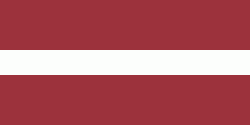Kārsava
 |
The ancient Baltic tribe Latgalians inhabited the territory of Kārsava since the 8th century. There are several hillforts near town.
In 1763 a Catholic church was built in Kārsava. The town was located near the Rēzekne-Ostrov postal road and it saw rapid development when the St. Petersburg-Vilnius railway line was constructed nearby and the town became a trading centre.
In 1935, on the eve of World War II, the population of Kārsava was 2,181, 37% of whom were Jewish. The vast majority of them were murdered during the Holocaust.
* List of cities in Latvia
Map - Kārsava
Map
Country - Latvia
 |
 |
| Flag of Latvia | |
After centuries of Teutonic, Swedish, Polish-Lithuanian and Russian rule, which was mainly executed by the local Baltic German aristocracy, the independent Republic of Latvia was established on 18 November 1918 when it broke away from the German Empire and declared independence in the aftermath of World War I. However, by the 1930s the country became increasingly autocratic after the coup in 1934 establishing an authoritarian regime under Kārlis Ulmanis. The country's de facto independence was interrupted at the outset of World War II, beginning with Latvia's forcible incorporation into the Soviet Union, followed by the invasion and occupation by Nazi Germany in 1941, and the re-occupation by the Soviets in 1944 to form the Latvian SSR for the next 45 years. As a result of extensive immigration during the Soviet occupation, ethnic Russians became the most prominent minority in the country, now constituting nearly a quarter of the population. The peaceful Singing Revolution started in 1987, and ended with the restoration of de facto independence on 21 August 1991. Since then, Latvia has been a democratic unitary parliamentary republic.
Currency / Language
| ISO | Currency | Symbol | Significant figures |
|---|---|---|---|
| EUR | Euro | € | 2 |
| ISO | Language |
|---|---|
| LV | Latvian language |
| LT | Lithuanian language |
| RU | Russian language |















